Plants, of course, don’t really breathe, but it is easy to visualize the plant breathing through the stomata: carbon dioxide in – oxygen out, carbon dioxide in – oxygen out….. you get the picture. This exchange of carbon dioxide and oxygen is called cellular respiration. During this process, plants use oxygen to breakdown the glucose produced during photosynthesis. Respiration is actually the opposite of photosynthesis. Let’s discuss this a bit more.
Please complete the post: Photosynthesis, Investigate the Amazing Power of Plants before continuing.
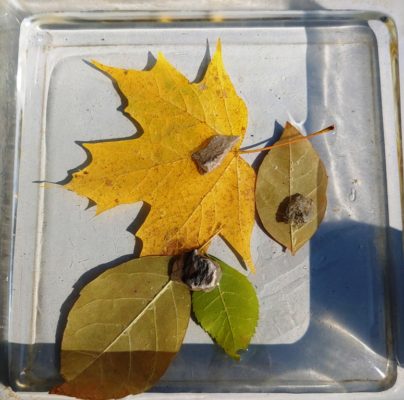
Try This Cellular Respiration Lab!
During cellular respiration, plants consume food to keep cells alive. This simple lab will visually prove that plants release oxygen.
Lab Supplies:
- Flat shallow bowl
- Water
- Several small pebbles.
- Leaf or plants part
- Sunlight
Fill a bowl with water and submerge the leaf upside down. How you lay the leaf is important because the stomata are on the backside of the leaf. If you need to you can anchor it with several small pebbles. Leave the bowl in sunlight for about an hour, then make your observations.
When you are swimming under water, what happens when you blow air out of your mouth? Bubbles move towards the surface of the water, right? The small bubbles that form on the leaf is the oxygen being released. It means the stomata are doing their jobs! Cool, huh?
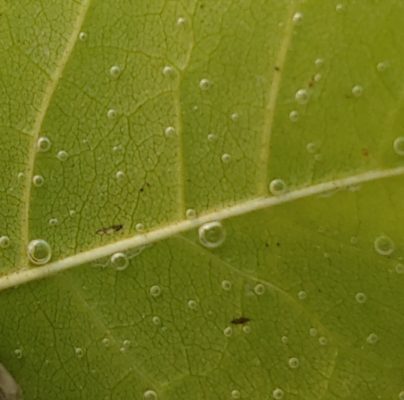
What-if Questions?
It is always important to ask questions. What if you try different parts of the plant? A whole flower? Petal? A conifer?
The Special Relationship between Plants and Humans
Plants release oxygen. Humans (and animals) breathe in oxygen. Humans breathe out carbon dioxide and plants take it in. Now that is a special relationship. So the next plant you pass, tell it thank you for the supply of oxygen that is keeping you alive!
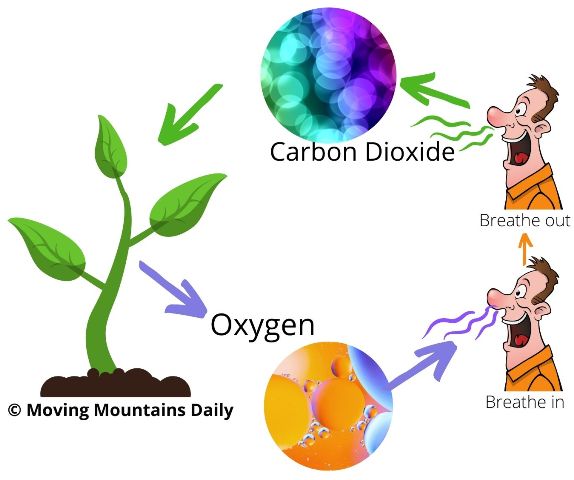
Do Plants Sleep at Night?
Photosynthesis requires light energy and the moon does not emit enough light, so food production can not occur during darkness. Cellular respiration, however, does not stop, it continues all night long.
WHAT-IF You repeat the same lab above, but instead put your bowl of water in a dark room. Do you notice any difference?
Nighttime Respiration
At night, there is not enough light for the photosynthesis process to continue. The chloroplast factories close down and the chlorophyll workers go home. All is quiet – or is it?
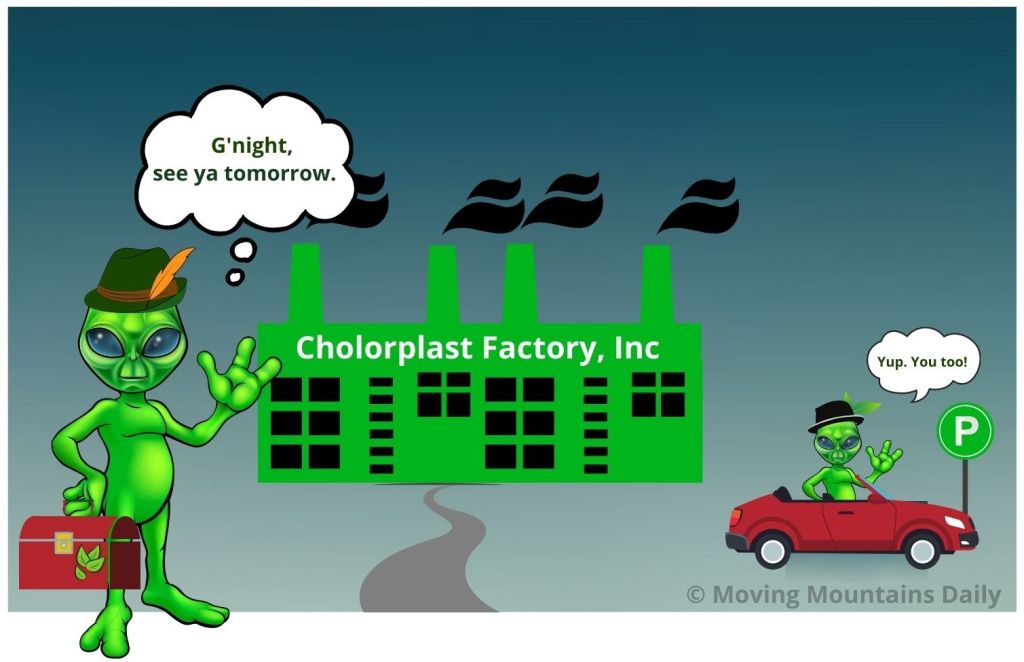
Thankfully, when we go to sleep at night our breathing continues. Plants continue to respire as well. Respiration occurs all day and night. Night time respiration is a bit different than during the daylight when photosynthesis factories are in full production.
During the day plants release oxygen, while at night the process is switched and plants take in oxygen and release carbon dioxide. Bet ya didn’t see that one coming!
The Difference
The difference between photosynthesis and cellular respiration is that during photosynthesis the plant makes food but during respiration energy created is consumed. Plant cells have to have nourishment just like we do! The glucose created during photosynthesis is a carbohydrate. In order to break down the carbs and create a reaction that creates energy, oxygen is needed. The amount of oxygen needed is dependent upon the light that is available.
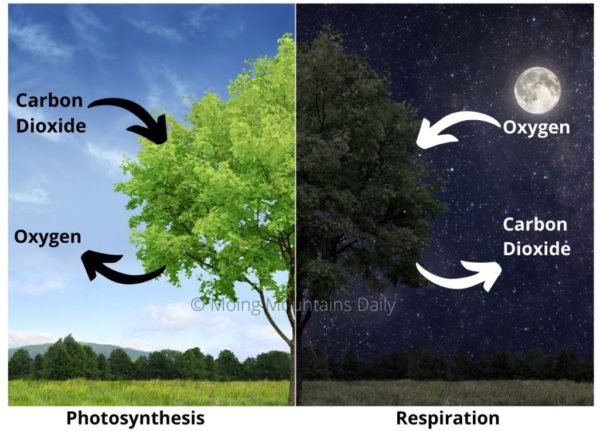
What happens when it is not sunny?
During bright sunlight photosynthesis is in full production. The plant uses oxygen to breakdown the glucose but it produces more food than it can consume. The excess glucose is stored away and excess oxygen that remains unused is released.
On cloudy days, photosynthesis and respiration continues but what is being made is equal to the same amount that is consumed by the plant. Food is not being stored away and little oxygen is being released because it is needed to break down the glucose.
Photosynthesis stops as the light diminishes and the moon rises, yet cellular respiration continues. The plant no longer producing food. Instead glucose is still being consumed using all available oxygen. Since carbon dioxide is not being used with light and water to create glucose, the plant releases the excess carbon dioxide.

What about photosynthesis and cellular respiration in the winter?
Deciduous trees in the winter go dormant meaning they have shed their leaves, they quit growing, and live off of stored glucose. Respiration slows down. There is not much going on so less food and energy is needed. Trees are programed to respond to seasonal changes. As the days become longer and temperatures warm, plants react to the seasonal change and soon springtime flowers bloom.
Evergreens, unlike deciduous trees, have a waxy coating on their leaves which seals in moisture and allows them to keep their green finery all year long. They continue photosynthesis in the winter, as long as there is enough water. However, photosynthetic reactions are much slower when the temperatures drops. (Have you completed our conifer labs?)
Taking the confusion out of Identifying Conifers for Kids
The Fascinating World of Gymnosperms for Kids
In Summary
Photosynthesis and cellular respiration are closely entwined as you can tell. Respiration is the use of oxygen to break apart the sugars produced by photosynthesis. During the process of breaking down the sugar, a reaction that creates energy is created, and consumed by the plant. It is the chemical reaction of these actions that releases gas (oxygen or carbon dioxide) into the air.
Vocabulary
Cellular Respiration – The process of breaking down glucose into a form that plant cells can use as energy.
Photosynthesis – The food making process by chemical reaction.
Stomata – Tiny opening on the underside of the leaf that open or close to allow gases in or out.
Glucose – A type of sugar created when plants use sunlight to convert oxygen and carbon dioxide.
Oxygen – The most common gas found in air and is created and released by plants.
Carbon Dioxide – A molecule needed by plants to make glucose. Humans and animals breathe it out and plants breathe it in.
Energy – The ability to do work.
Deciduous – Trees that loose their leaves during the winter season.
Conifers – Evergreens that remain green all year long.
Have you subscribed? Our readers are updated on all the latest from the blog. You will know if a unit is expanded or a new subject introduced.
Subscriber benefits:
- A monthly newsletter
- The ‘Latest from the Blog’
- Monthly Living Book reading suggestions
- Automatic inclusion to all promotions and giveaways
- And, of course, the guarantee that we will never give out your information.


